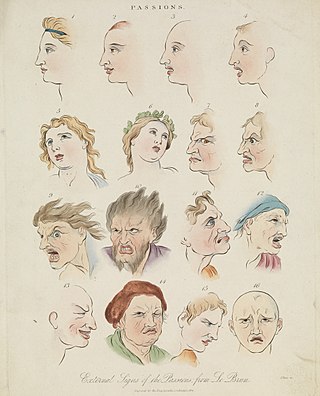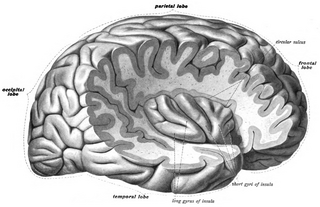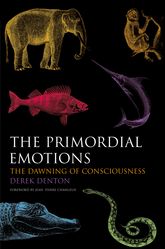
Emotions are physical and mental states brought on by neurophysiological changes, variously associated with thoughts, feelings, behavioral responses, and a degree of pleasure or displeasure. There is no scientific consensus on a definition. Emotions are often intertwined with mood, temperament, personality, disposition, or creativity.
Feelings are subjective self-contained phenomenal experiences. According to the APA Dictionary of Psychology, a feeling is "a self-contained phenomenal experience"; and feelings are "subjective, evaluative, and independent of the sensations, thoughts, or images evoking them". The term feeling is closely related to, but not the same as, emotion. Feeling may for instance refer to the conscious subjective experience of emotions. The study of subjective experiences is called phenomenology. Psychotherapy generally involves a therapist helping a client understand, articulate, and learn to effectively regulate the client's own feelings, and ultimately to take responsibility for the client's experience of the world. Feelings are sometimes held to be characteristic of embodied consciousness.

Sentience is the simplest or most primitive form of cognition, consisting of a conscious awareness of stimuli without association or interpretation. The word was first coined by philosophers in the 1630s for the concept of an ability to feel, derived from Latin sentiens (feeling), to distinguish it from the ability to think (reason).
Developed in his (1999) book, "The Feeling of What Happens", Antonio Damasio's theory of consciousness proposes that consciousness arises from the interactions between the brain, the body, and the environment. According to this theory, consciousness is not a unitary experience, but rather emerges from the dynamic interplay between different brain regions and their corresponding bodily states. Damasio argues that our conscious experiences are influenced by the emotional responses that are generated by our body's interactions with the environment, and that these emotional responses play a crucial role in shaping our conscious experience. This theory emphasizes the importance of the body and its physiological processes in the emergence of consciousness.

Antonio Damasio is a Portuguese neuroscientist. He is currently the David Dornsife Chair in Neuroscience, as well as Professor of Psychology, Philosophy, and Neurology, at the University of Southern California, and, additionally, an adjunct professor at the Salk Institute. He was previously the chair of neurology at the University of Iowa for 20 years. Damasio heads the Brain and Creativity Institute, and has authored several books: his work, Self Comes to Mind: Constructing the Conscious Brain (2010), explores the relationship between the brain and consciousness. Damasio's research in neuroscience has shown that emotions play a central role in social cognition and decision-making.

Descartes' Error: Emotion, Reason, and the Human Brain is a 1994 book by neuroscientist António Damásio describing the physiology of rational thought and decision, and how the faculties could have evolved through Darwinian natural selection. Damásio refers to René Descartes' separation of the mind from the body as an error because reasoning requires the guidance of emotions and feelings conveyed from the body. Written for the layperson, Damásio uses the dramatic 1848 railroad accident case of Phineas Gage as a reference for incorporating data from multiple modern clinical cases, enumerating damaging cognitive effects when feelings and reasoning become anatomically decoupled. The book provides an analysis of diverse clinical data contrasting a wide range of emotional changes following frontal lobe damage as well as lower (medulla) and anterior areas of the brain such as the anterior cingulate. Among his experimental evidence and testable hypotheses, Damásio presents the "somatic marker hypothesis", a proposed mechanism by which emotions guide behavior and decision-making, and positing that rationality requires emotional input. He argues that René Descartes' "error" was the dualist separation of mind and body, rationality and emotion.

The insular cortex is a portion of the cerebral cortex folded deep within the lateral sulcus within each hemisphere of the mammalian brain.

The somatic marker hypothesis, formulated by Antonio Damasio and associated researchers, proposes that emotional processes guide behavior, particularly decision-making.
Reduced affect display, sometimes referred to as emotional blunting or emotional numbing, is a condition of reduced emotional reactivity in an individual. It manifests as a failure to express feelings either verbally or nonverbally, especially when talking about issues that would normally be expected to engage emotions. In this condition, expressive gestures are rare and there is little animation in facial expression or vocal inflection. Additionally, reduced affect can be symptomatic of autism, schizophrenia, depression, post-traumatic stress disorder, depersonalization disorder, schizoid personality disorder or brain damage. It may also be a side effect of certain medications.
Derek Ashworth Denton was an Australian scientist who elucidated the regulation of electrolytes in extracellular fluid, the hormones controlling this regulation, particularly aldosterone, and the instinctive behaviours controlling intake of water and salts. He was cited in 1995 at election to the U.S. National Academy of Sciences as the world’s leading authority on the regulation of salt and water metabolism and relevant endocrine control mechanisms. He was one of Australia’s most eminent scientists.
The theory of constructed emotion is a theory in affective science proposed by Lisa Feldman Barrett to explain the experience and perception of emotion. The theory posits that instances of emotion are constructed predictively by the brain in the moment as needed. It draws from social construction, psychological construction, and neuroconstruction.

Animal consciousness, or animal awareness, is the quality or state of self-awareness within an animal, or of being aware of an external object or something within itself. In humans, consciousness has been defined as: sentience, awareness, subjectivity, qualia, the ability to experience or to feel, wakefulness, having a sense of selfhood, and the executive control system of the mind. Despite the difficulty in definition, many philosophers believe there is a broadly shared underlying intuition about what consciousness is.
One way of thinking holds that the mental process of decision-making is rational: a formal process based on optimizing utility. Rational thinking and decision-making does not leave much room for emotions. In fact, emotions are often considered irrational occurrences that may distort reasoning.

Frisson, also known as aesthetic chills or psychogenic shivers, is a psychophysiological response to rewarding stimuli that often induces a pleasurable or otherwise positively-valenced affective state and transient paresthesia, sometimes along with piloerection and mydriasis . The sensation commonly occurs as a mildly to moderately pleasurable emotional response to music with skin tingling; piloerection and pupil dilation not necessarily occurring in all cases.
Primary consciousness is a term the American biologist Gerald Edelman coined to describe the ability, found in humans and some animals, to integrate observed events with memory to create an awareness of the present and immediate past of the world around them. This form of consciousness is also sometimes called "sensory consciousness". Put another way, primary consciousness is the presence of various subjective sensory contents of consciousness such as sensations, perceptions, and mental images. For example, primary consciousness includes a person's experience of the blueness of the ocean, a bird's song, and the feeling of pain. Thus, primary consciousness refers to being mentally aware of things in the world in the present without any sense of past and future; it is composed of mental images bound to a time around the measurable present.
Affect consciousness refers to an individual's ability to consciously perceive, tolerate, reflect upon, and express affects. These four abilities are operationalized as degrees of awareness, tolerance, emotional (nonverbal) expression, and conceptual (verbal) expression of each of the following eleven affect categories:
Hunger is a sensation that motivates the consumption of food. The sensation of hunger typically manifests after only a few hours without eating and is generally considered to be unpleasant. Satiety occurs between 5 and 20 minutes after eating. There are several theories about how the feeling of hunger arises. The desire to eat food, or appetite, is another sensation experienced with regard to eating.

The Primordial Emotions: The Dawning of Consciousness is a 2006 book by Australian neuroscientist Derek Denton.
The self-transforming brain refers to the ability of the self to consciously use mental activity to change/modify the brain's neural network in order to experience life with more happiness and fulfillment. This capacity of using awareness to do so is based on the assumption that the brain and the mind are closely connected, that one does not change without the other. The phrase "I think therefore I am" is not only a famous proclamation in the eyes of neuroscience. It has been evidenced that mental activities such as fleeting thoughts and feelings can create new neural structures in the brain and thus shape a person's reality. Therefore, it is possible to make use of the brain's neuroplasticity to re-wire or change one's brain and life by consciously activating happy, tranquil and loving mental states.

Interoception is the collection of senses providing information to the organism about the internal state of the body. This can be both conscious and subconscious. It encompasses the brain's process of integrating signals relayed from the body into specific subregions—like the brainstem, thalamus, insula, somatosensory, and anterior cingulate cortex—allowing for a nuanced representation of the physiological state of the body. This is important for maintaining homeostatic conditions in the body and, potentially, facilitating self-awareness.












